Do you want to start a WordPress blog the right way?
We know that starting a blog can be a terrifying thought, especially when you are not geeky. Guess what – you are not alone.
Having helped over 2 million+ users create a blog, we have decided to create a step-by-step guide on how to create a blog for beginners without any technical knowledge.
In this in-depth guide, we’ll walk you through the entire process. We’ll also talk about working on your blog and growing it steadily.
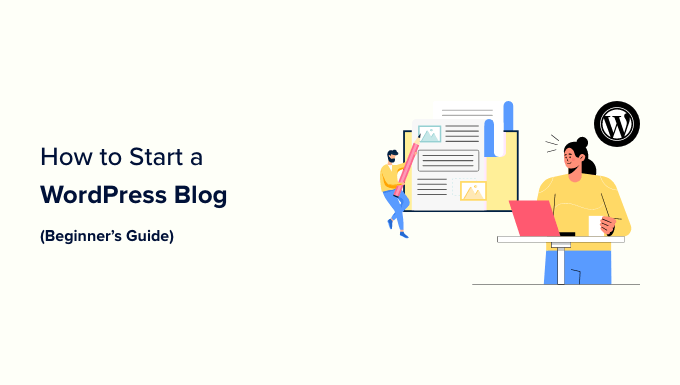
The process is easy to follow whether you are 20 years old or 60 years old. However, if you need help, our expert team will help you set up your blog for free. → Click Here to Get Your Free WordPress Blog Setup! ←
What Do You Need to Start a WordPress Blog?
There are three things you need to create a WordPress blog:
- A domain name idea (this will be the name of your blog, i.e., wpbeginner.com)
- A web hosting account (this is where your website lives on the internet)
- Your undivided attention for 30 minutes.
Yes, you read it right. You can start a blog from scratch in less than 30 minutes, and we will walk you through the whole process step by step.
In this tutorial, we will cover:
Ready? Let’s get started.
Video Tutorial
If you don’t like the video or need more instructions, then continue reading.
Step 1. Pick Your Blog Name and Platform
The biggest mistake beginners make when building a blog is choosing the wrong blogging platform. Thankfully, you’re here and won’t be making that mistake.
For 95% of users, it makes more sense to use WordPress.org, also known as self-hosted WordPress.
That’s because WordPress is open-source, which means it is 100% free to use. You can install plugins, customize your blog design, and most importantly, make money from your blog without any restrictions (see the difference between WordPress.com vs. WordPress.org).
WordPress is also the number one website platform used by all successful blogs, including our own. To put it in perspective, 43% of all websites on the internet use WordPress!
Now you might be wondering why WordPress is free. What’s the catch?
There’s no catch. It’s free because you have to do the setup and host it yourself.
In other words, you will need a domain name and web hosting.
A domain name is what people type to get to your website. It’s your blog’s address on the internet. Think google.com or wpbeginner.com
Web hosting is where your website files live. It’s your website’s house on the internet. Every blog needs web hosting.
A new domain name typically costs around $14.99 / year, and web hosting plans normally cost $7.99 / month.
That’s a lot of money for beginners who are just starting out.
Thankfully, Bluehost, an official WordPress-recommended hosting provider, has agreed to offer our users a free domain name and a generous discount on web hosting.
You can also use other popular WordPress hosting companies like SiteGround or Hostinger, and still be able to follow our blog setup tutorial.
We recommend Bluehost for beginners because it is one of the oldest web hosting companies on the internet. They are also the largest brand name when it comes to WordPress hosting because they host millions of websites, including many of our own.
On top of all this, Bluehost has been working with WordPress since 2005, and they are committed to giving back.
That’s why they have promised us that if you cannot get your blog online within 30 minutes by following this tutorial, then our expert team will complete the process for you without any cost. They will compensate us, so you don’t have to. Contact us for free blog setup help.
NOTE: At WPBeginner, we believe in transparency. If you sign up with Bluehost using our referral link, we will earn a small commission at no extra cost to you (in fact, you will save money and get a free domain). We would get this commission for recommending just about any WordPress hosting company, but we only recommend products that we personally use and believe will add value to our readers.
Let’s go ahead and purchase your domain + hosting.
Open up Bluehost in a new window and follow along.
The first thing you need to do is click on the green Get Started Now button to get started.
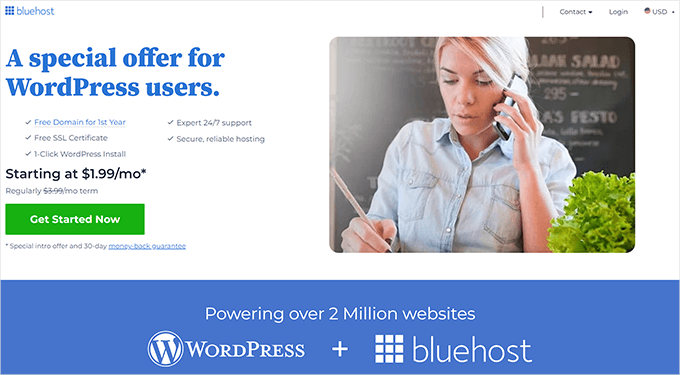
On the next screen, select the plan that you need (Basic and Choice Plus are the most popular).
After that, you will be asked to enter the domain name for your website.
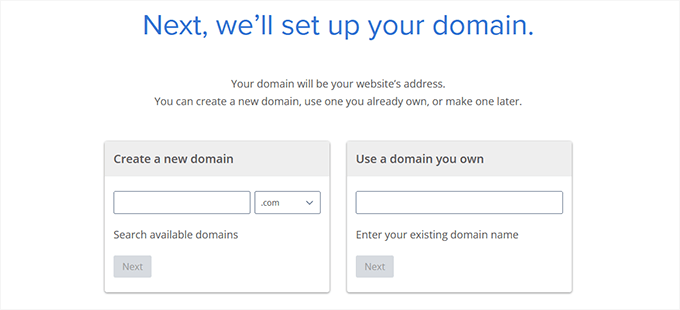
Lastly, you will need to add your account information and finalize the package info to complete the process. We recommend going with the 12-month plan because that’s the best value.
On this screen, you will see optional extras that you can purchase. It’s entirely up to you whether or not you purchase these, but we generally don’t recommend purchasing them right away.
You can always add them later on if you decide that you need them.
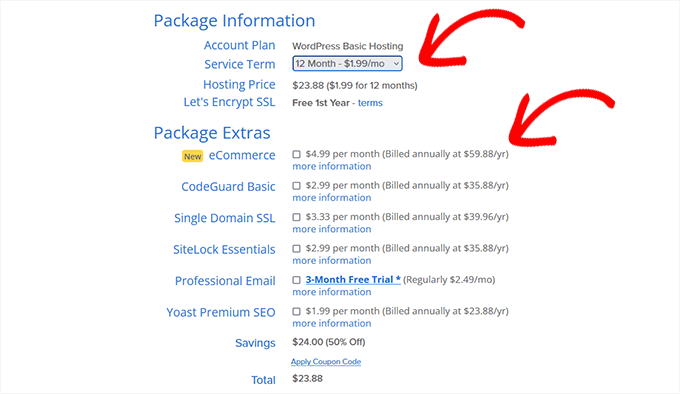
Once completed, you will receive an email with details on how to log in to your web hosting control panel (cPanel).
This is where you manage everything from support emails to FTP access among other things. But most importantly, this is where you install WordPress.
Step 2. Install WordPress Blogging Software
When you sign up with Bluehost using our link, they will automatically install WordPress for you, so you can start building your blog right away.
Simply log in to your Bluehost account, and then click the Login to WordPress button to get started.
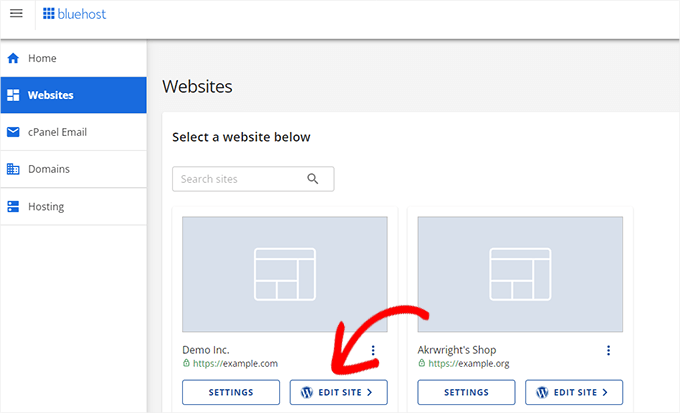
You can also log in to WordPress by going to yoursite.com/wp-admin/ directly from your browser.
If you are using a different WordPress blog hosting service like SiteGround, Hostinger, WP Engine, etc, then you can see our comprehensive guide on how to install WordPress for step-by-step instructions for those providers.
Most of the above blog hosting companies are now also automatically installing WordPress to help non-techy users kickstart their blogging journey.
Once WordPress is set up, you’re ready to create your blog pages, customize your blog’s design, and start blogging.
Step 3. Selecting Your WordPress Theme
The visual appearance of your WordPress blog is controlled by blog themes. When you first visit your blog, it will look something like this:
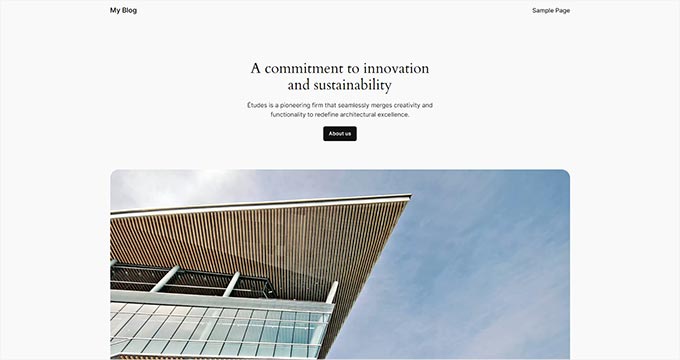
This is not very appealing to most people.
Customizing the look and feel of your blog is by far one of the most exciting and rewarding parts of the journey of creating your WordPress blog.
There are thousands of pre-made WordPress themes that you can install on your site. Some of them are free themes, while others are paid premium themes.
You can change your theme by going to your WordPress dashboard and clicking on Appearance » Themes.
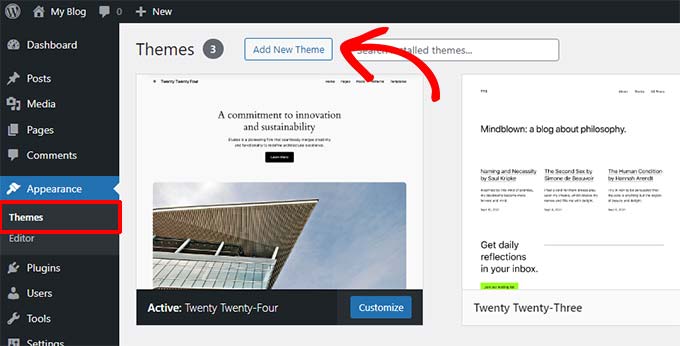
Go ahead and click on the Add New Theme button.
On the next screen, you will able to search from 11,000+ free WordPress themes that are available in the official WordPress.org themes directory. You can sort by Popular, Latest, Block Themes, as well as other feature filters (i.e. industry, layout, etc.).
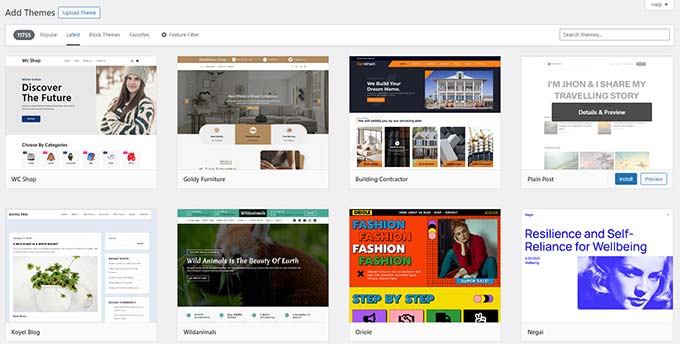
You can take your mouse over to a new theme, and you will see a Preview button.
Clicking on it will open the theme preview where you can see how the design would look on your website.
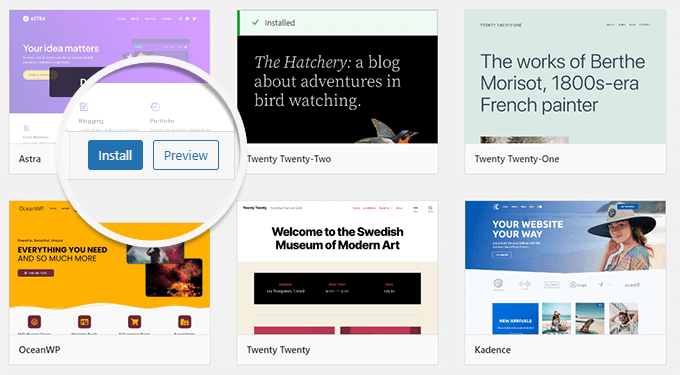
The preview of your theme may not look exactly as shown in the screenshot, which is normal as you will get to customize and set it up later.
What you need to look for is design, colors, typography, and other elements.
The best tip to select the perfect WordPress theme is to strive for simplicity in design. It helps you keep things clean and clear while offering a good experience to your users.
If you need help selecting a theme, then please refer to our guide on things you should consider when selecting a perfect WordPress theme.
When you have found the theme that you like, simply bring your mouse on it, and it will show the Install button.
Click on it and wait for the theme to be installed. After that, the install button will be replaced with an Activate button. You need to click on it to Activate the theme.
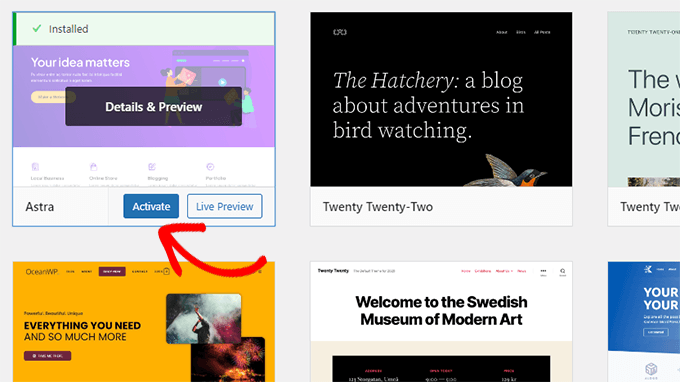
Once you have installed your theme, you can customize it by clicking on the Customize link under the Appearance menu.
Depending on the theme you choose, there will be built-in widgets and customization options that let you tweak your blog design.
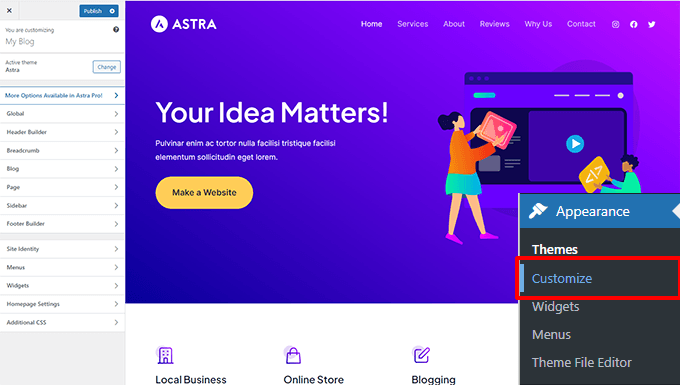
Note: If you cannot see the customize link under the Appearance menu, then this means you are using a block theme. Block themes use the WordPress block editor to edit and customize a WordPress theme.
You can edit a block theme by visiting the Appearance » Editor page.
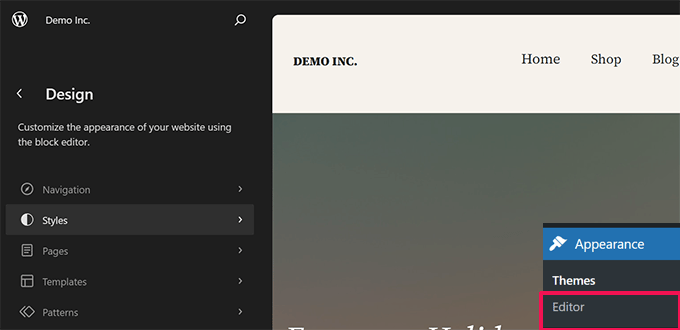
You can get even more design control with a WordPress page builder like SeedProd or Divi, which let you create a custom header, footer, sidebar, and more without writing any HTML code.
These plugins give you more design control than what you get with Wix or Squarespace while giving you the full freedom of the powerful WordPress content management system.
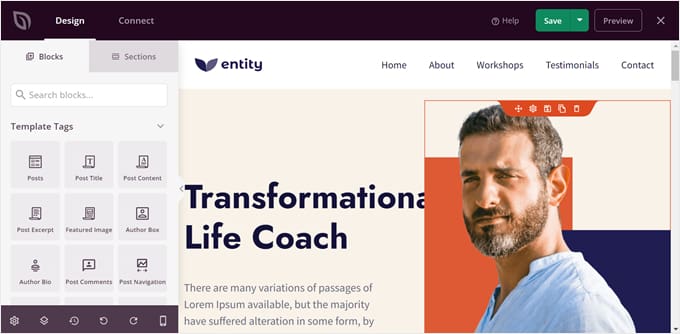
Once you have selected your WordPress theme, you are now ready to create your first blog post.
Alternative: You can get your dream blog designed by expert WordPress developers at an affordable price with WPBeginner Pro Services. Custom web design includes bespoke homepage design, professional logo, 5 templated subpages, blog setup, and more.
Step 4. Creating Your First Blog Post
To write your first blog post, click the Posts » Add New menu in your WordPress dashboard.
You will see an editor area where you can write your first blog post.
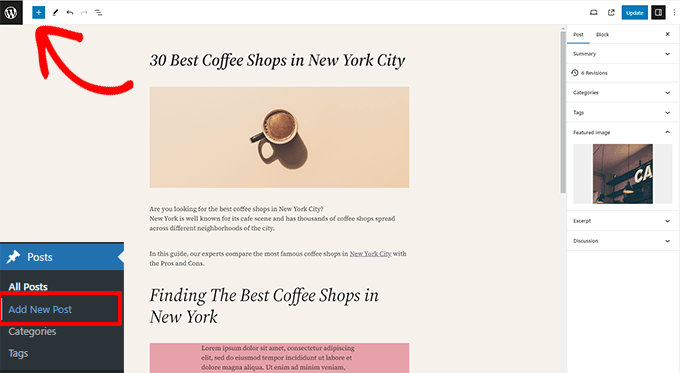
WordPress uses a block-based editor that allows you to create beautiful content layouts for your blog posts.
To familiarize yourself with the editor, see our WordPress block editor tutorial.
Once you’re done writing, go ahead and click on the Publish button on the top-right corner of the screen to make your blog post publicly available.
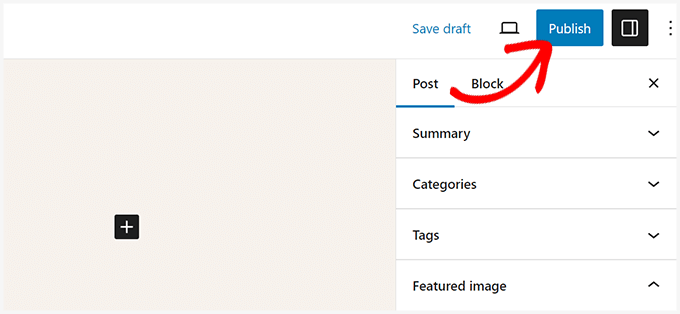
On the posts screen, you will notice several other sections, such as Categories and Tags. You can use these to organize your blog posts into sections.
We have a great write-up on the difference between categories vs tags, which we highly recommend that you read.
To utilize all the features on the posts screen, you should read our article on how to add a new post in WordPress (video included).
It covers how to embed videos, add blog images, headings, table of contents, sub-headers, bullet lists, call-to-action buttons, social media posts, and all other shortcuts you need.
Often, beginners are confused between Posts and Pages menus in the WordPress dashboard. That’s why we have also written a complete guide on the difference between posts vs pages in WordPress.
If you need help brainstorming new blog post ideas to write about, then here are some helpful resources:
- Free blog post idea generator tool by WPBeginner
- 103 blog post ideas that your readers will love
- 73 types of blog topics that are proven to work
- How to write a great blog post (structure + examples)
- How to create an effective content plan in WordPress
Many pro bloggers choose their specific topics strategically by doing keyword research. This helps their content rank higher in Google search and get more traffic.
We have a step-by-step guide on how to do keyword research for beginners using the exact same method that we use on WPBeginner.
Step 5. Plugins & Customizations
Once you have written your first blog post, you probably want to get started with adding other usual elements to your website, such as a contact page, galleries, sliders, email lists, forums, etc.
To add all these additional features, you need to use plugins.
Plugins are like apps for your WordPress website. They allow you to add new features to your site (without writing any code).
There are over 59,000+ WordPress plugins available in the free WordPress plugin directory alone. This means no matter what you want to accomplish, there is a plugin for it.
We have a step-by-step guide on how to install a WordPress plugin.
That being said, let’s take a look at how to use plugins to add some essential features to your WordPress blog.
How to Create a Contact Form in WordPress
Every website needs a contact form. It allows your users to email you directly. Since WordPress doesn’t come with a built-in contact form, you will need a WordPress form builder plugin to add a contact form to your site.
We recommend using the WPForms Lite plugin. It is a free version of the popular WPForms plugin, which is #1 in our list of best contact form plugins for WordPress.
Over 6 million websites use WPForms!
You can install the plugin by going to Plugins » Add New page and typing WPForms in the search box. Next, you need to click “Install” and then “Activate”. Upon activation, you need to head over to the WPForms » Add New page to create your first form.
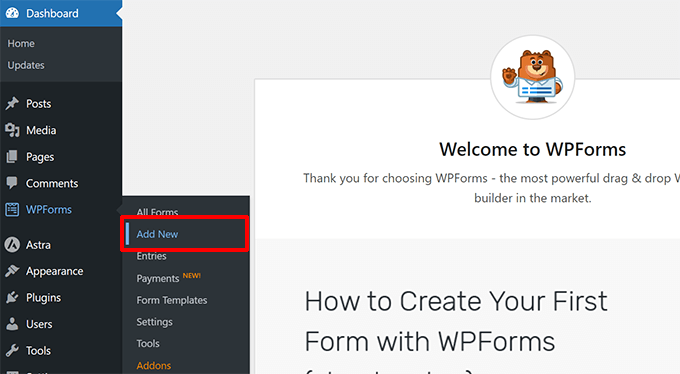
This will open the WPForms builder interface.
First, you need to enter a name for your contact form and then click on ‘Simple Contact Form’ template.
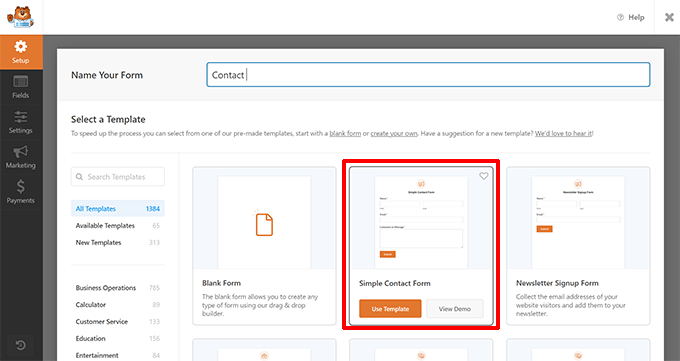
WPForms will now create a simple contact form for you with all the required fields.
You can click on any field to change it or add a new field from the left column.
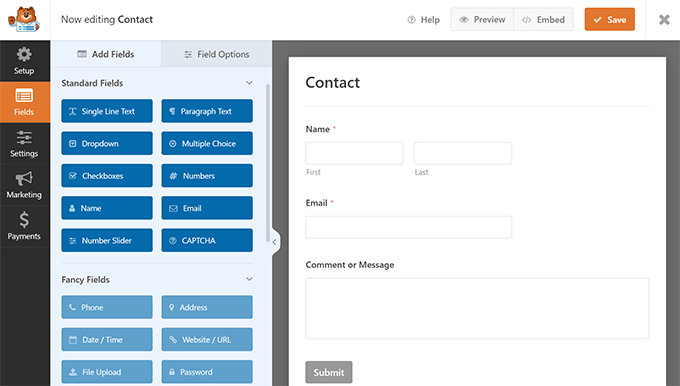
Once you are done editing the form, click on the save button at the top right corner and then exit the form builder.
You can now create a new page in WordPress by going to Pages » Add New Page and naming it ‘Contact.’
On the edit screen, you need to add the WPForms block into the editor.
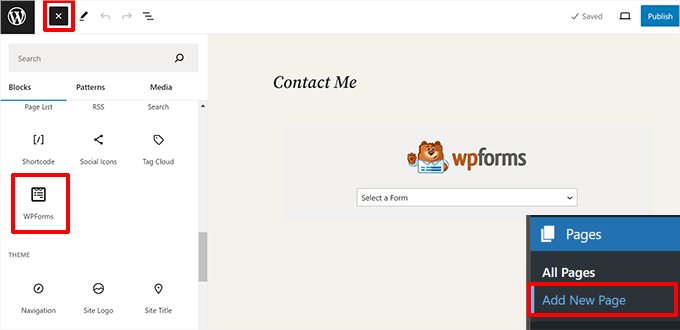
After that, select the form you created earlier from the drop-down menu.
WPForms will load a live preview of the form in the editor.
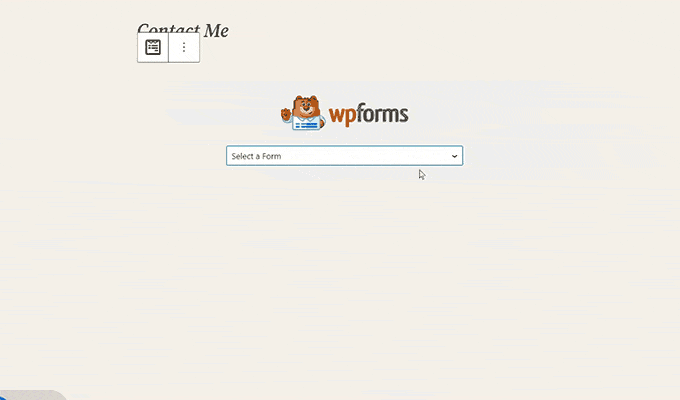
You can now save and publish the page and visit it in your browser to see your contact form in action.
It’s a best practice to test your form to make sure you’re receiving the notifications. If you don’t get the notification, then you should see our guide on how to fix WordPress not sending emails.
If you need more detailed instructions, then see our step-by-step guide on how to create a contact form in WordPress.
As a blogger, the best part about WPForms is that it grows with you. Aside from simple contact forms, you can also use it to create reader surveys, polls, guest post submission forms, and more.
How to Setup Google Analytics Tracking
Google Analytics helps you see how many people are visiting your blog, where they are coming from, and what they are doing on your website.
It is best to install Google Analytics when starting your blog so you can see how much it has grown over time.
First, you need to visit the Google Analytics website and sign in using your Gmail account.
Once you are logged in, you can go ahead and sign up for a free Google Analytics account.
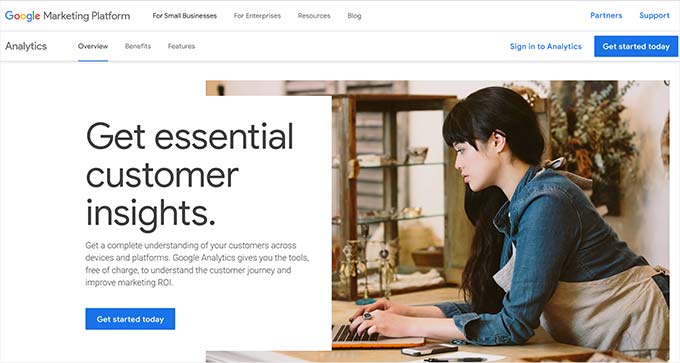
You will be asked to provide your information and website URL. After that, you will be presented with your Google Analytics tracking code.
You can stop here because we will be using a plugin to automatically fetch and add this code to your blog (along with setting up proper WordPress tracking).
Switch to your WordPress admin area to install and activate the MonsterInsights plugin. It is the free version of the best Google Analytics plugin for WordPress, and it is the easiest way to add Google Analytics on your site (trusted by over 3 million websites).
Upon activation, you need to visit Insights » Settings page to configure the plugin settings.
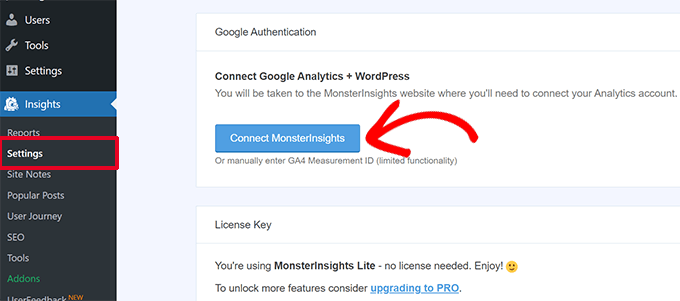
On the settings page, click on the ‘Connect MonsterInsights’ button to connect Google Analytics to your WordPress site.
Follow the on-screen instructions to complete the setup. Once done, you will be able to see your website analytics report straight from your WordPress dashboard under the MonsterInsights tab.
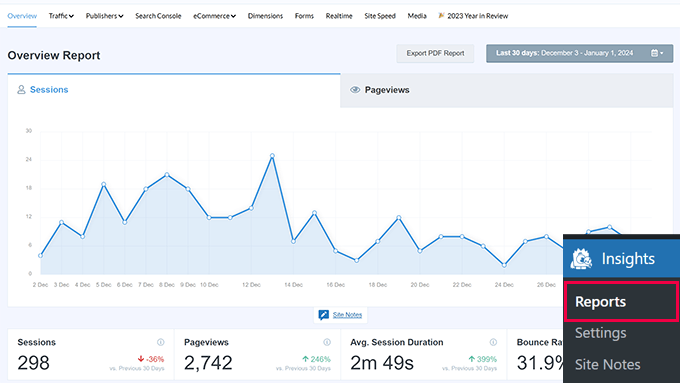
For detailed instructions, see our article on how to install Google Analytics in WordPress.
How to Optimize Your WordPress Blog for SEO
Most beginners don’t optimize for SEO when creating a blog. SEO or search engine optimization helps users find your blog in search engines.
If you want more traffic, then it’s crucial that you optimize your blog for SEO right from the beginning.
To get started, you first need to install and activate the All in One SEO plugin. It is the complete WordPress SEO plugin that will help you optimize your blog.
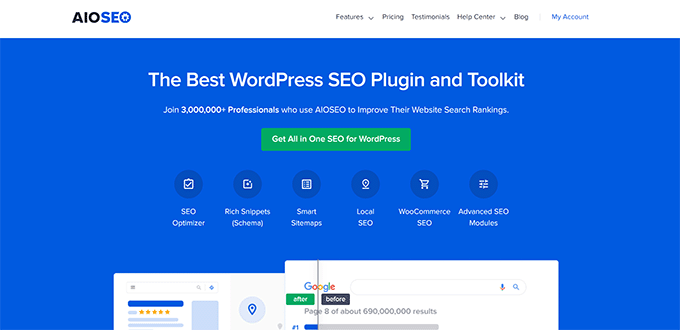
The plugin comes with a quick configuration wizard to help you walk through the setup.
It will help you configure a WordPress sitemap, write proper keywords and meta descriptions, add schema markup, and more.
We also recommend you follow our complete step-by-step WordPress SEO guide to set up your blog’s SEO.
Now there are other SEO plugins like Yoast SEO, RankMath, etc, but we recommend using AIOSEO because it offers the most beginner-friendly interface for new bloggers. We use it on all our blogs, including WPBeginner.
The free version of AIOSEO is pretty good and is used by over 3 million websites.
Aside from a WordPress SEO plugin, you can further optimize your blog content by using a keyword research tool. These SEO tools help you come up with new content ideas that people are searching for around your topic.
You can even see the exact keywords your competitors are ranking for, so you can create better content and outrank them.
This helps you maximize the traffic on your new blog site right from the beginning. For more details, see our newbie’s guide on how to do keyword research for your own blog.
More WordPress Plugins and Customizations
There are a ton of other WordPress plugins that you can install. Often, beginners find it a bit overwhelming to search for the plugins they need.
At WPBeginner, we often feature the best WordPress plugins to help you add the functionality that you need.
Here is our expert pick of the best WordPress plugins that you should check out.
- Backup – Duplicator is the best WordPress backup plugin. You need to create regular backups of your website in case something ever goes wrong.
- Security – Sucuri Security is a free security scanner for WordPress. We have a complete step-by-step WordPress security guide for beginners that will help you secure your blog.
- Performance – We recommend using either WP Rocket (premium) or WP Super Cache (free) to speed up WordPress. For more on this topic, see our article on WordPress speed and performance with step-by-step instructions.
- Design & Customization – We recommend using either SeedProd or Divi page builder for customizing your homepage design, creating custom landing pages, or even creating custom themes (without writing any code). For more on this topic, see our article on the best WordPress page builders (compared).
- Traffic & Subscribers – We strongly recommend using push notifications by PushEngage. This lets you connect with visitors after they leave your website. It’s our top 5 traffic source on WPBeginner. For more details, see how to add push notifications in WordPress.
- Email Marketing – We recommend using Constant Contact or HubSpot as your email marketing service. To get more email subscribers, we recommend using the OptinMonster free plugin to create high-converting popups, scroll boxes and calls to action.
Need a WordPress plugin or tool but not sure which one to use? Take a look at WPBeginner’s Solutions Center. It is a curated library of the best WordPress plugins and tools, hand-picked and thoroughly tested by our WordPress experts.
If you are curious about all the plugins and tools that we use on our website, then check out WPBeginner’s Blueprint. That list contains all the tools that we use to grow the WPBeginner blog.
Need more recommendations? See our expert pick of the must-have WordPress plugins and tools for all websites (hand-picked by our founder, Syed Balkhi).
Step 6. Making Money From Your Blog
Now that you’ve created your personal blog and customized it to your liking, you are probably wondering how I can actually make money blogging.
There are a lot of different ways to successfully monetize your blog. However, there is no such thing as a get-rich-quick scheme.
Don’t be fooled by the pictures of expensive cars and mansions because those are all fake.
Unlike other “make money online” articles, we have created the most comprehensive guide on how to make money from your blog using WordPress.
That’s a 4000+ word guide that everyone who wants to make money with their blog needs to read. We have shared our 15+ years of online wisdom in that ultimate guide.
As long as you’re willing to put in the hard work and effort, you’ll reap the reward. Remember, there are no shortcuts.
Here are some of the best ways to make money from your blog.
1. Google AdSense

Many bloggers make money by showing ads on their blogs. If you make a blog with monetization in mind, then Google AdSense is the best way to do this.
It is the largest advertising platform for bloggers and publishers. Acting as a middleman between you and the advertiser, Google allows advertisers to bid for keywords matching your content. This allows you to get the best rates possible for the ads.
For more details, see our article on how to properly add Google AdSense to your WordPress blog.
2. Affiliate Marketing
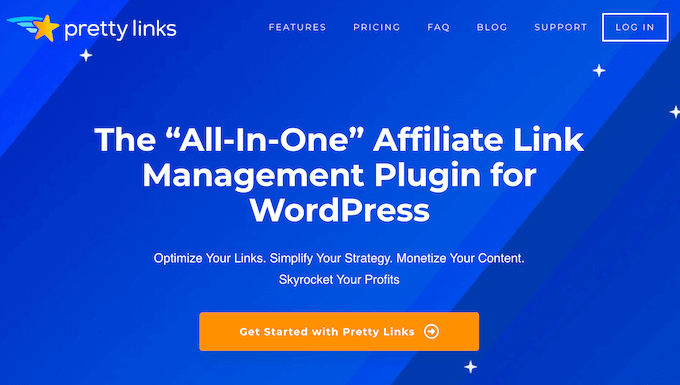
Affiliate marketing is the second most commonly used monetization strategy among bloggers. Basically, you recommend your favorite products/services to your readers, and when they make a purchase, you get a referral commission.
The key in affiliate marketing is to recommend high-quality products and services that you already use and trust.
There are plenty of affiliate marketing plugins and tools for WordPress that can help you make more money when promoting affiliate products. We recommend using PrettyLinks or ThirstyAffiliates as a must-have.
We also have a complete step-by-step affiliate marketing guide for beginners, that will help you get started with choosing the right affiliate program and strategies to monetize your blog today.
3. Online Store

Many bloggers make money by selling things directly from their blogs. This could be physical products or digital downloads like ebooks, artwork, music, and more. Some bloggers even offer consulting services.
If you’re looking to sell digital products like eBooks, then we recommend using Easy Digital Downloads because this is the plugin that we use ourselves. It has all the features you need to sell digital downloads.
If you’re looking to sell physical products, then we recommend using WooCommerce because it is the best eCommerce plugin for WordPress. It is also the most commonly used eCommerce platform in the world.
For detailed instructions, see our guide on how to easily create an online store using WordPress.
Some bloggers don’t want the hassle of creating a store to sell their own products, so they create an Amazon affiliate store, which lets them sell other people’s products from Amazon and earn a commission.
On top of the three methods above, you can do so much more with your WordPress blog. You can make WordPress blogs specifically for reviews, fashion blogging, food blogging with recipes, and more. Each of these blog types brings you more unique opportunities to make money.
You can also turn your blog into a membership site to offer premium content and courses. We have a detailed guide on how to create and sell online courses with WordPress.
Step 7. Mastering WordPress
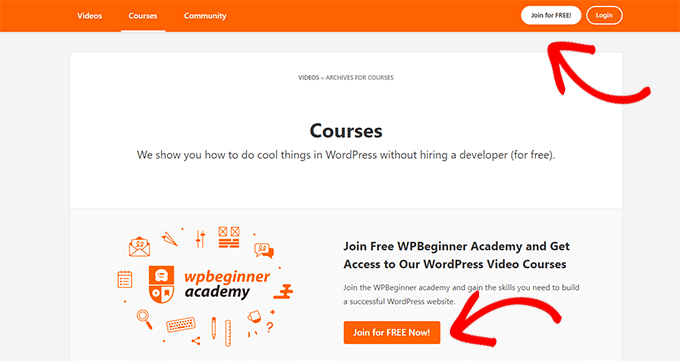
WPBeginner is the largest free WordPress resource site for beginners.
At WPBeginner, our main goal is to provide cutting-edge, helpful WordPress tutorials that are easy to understand for small businesses, bloggers, and non-techy WordPress website owners (see more about us).
To expand your WordPress knowledge, you should check out:
- WPBeginner Dictionary – The best place for beginners to start and familiarize themselves with the WordPress lingo
- WPBeginner Videos – New to WordPress? WPBeginner Videos offers free WordPress courses for beginners.
- WPBeginner Blog – The central place for all our WordPress tutorials.
For more discussions, you may want to join our free Facebook group WPBeginner Engage. With more than 97,000 members, the group is focused on helping beginners and non-tech users do more with WordPress.
You can also subscribe to WPBeginner’s YouTube Channel, where we regularly share video tutorials to help you learn WordPress.
Lastly, you can use Google to type your question and add WPBeginner in front of it. Our users find this trick to be always helpful because it makes it easy for you to find the RIGHT answer for your WordPress questions.
In case you don’t find an answer to your question, don’t worry. Simply use our contact form to send us a message. Our always helpful, full-time WPBeginner support team will be happy to assist. We love helping users get started with WordPress.
Frequently Asked Questions (FAQs)
Having helped thousands of people start a blog, we have answered quite a lot of questions. Below are the answers to the most frequently asked questions about creating a blog.
Can I create a blog without WordPress?
Yes, there are several other blogging platforms available. We have compared them all, and WordPress is by far the best website builder solution in the market for making a blog with complete ownership and freedom.
Can I build a blog without hosting?
No, that’s not possible. Web hosting is where your website files are stored. All websites need web hosting. To start a blog, you will need your own domain and web hosting.
Is it free to start a blog on WordPress?
WordPress itself is available for free. However, you’ll need to pay for hosting and domain name. Alternatively, you can start with a free blog on WordPress.com, keeping in mind the limitations of WordPress.com and how it differs from WordPress.org.
How do I come up with a good blog name for my site?
Most personal blog names are named after their creator. Other blogs are named after the topic or industry they are in. We have an AI powered business name generator that you can use to come up with blog name ideas.
What is the best blogging niche?
Choosing the right niche for your blog makes it easier to create engaging content and make more money online. Our experts have researched the 7 best blogging niches that you should consider when starting your blog.
We also created a list of the 18 most popular types of blogs to help you get inspiration.
How much does it cost to start a blog?
The cost depends on the add-ons that you buy. We have a complete guide on how much does a WordPress website cost as well as tips on how to save money.
Most blogging tools are either free or come with a 30-day money-back guarantee, so you can try them risk-free.
Can I create a blog without my parents knowing about it?
Yes. You can make your WordPress blog private and hide it from the internet. Here is a step-by-step guide on how to make your WordPress blog completely private.
Can I start a WordPress blog and make money with Google Adsense?
Yes, you can use your WordPress blog to earn money from Google AdSense. We have a step-by-step guide on how to add Google AdSense to WordPress.
How can I create a blog and remain anonymous?
If you want to have a public-facing blog but want to remain anonymous, then you need to make sure that your domain has WHOIS privacy turned on. Often, people use a pseudonym/nickname to write under. You should also create a unique email just for your blog. It goes without saying, don’t post your pictures or anything on the blog. For more detailed instructions, see our article on how to blog anonymously using WordPress.
How do I add a podcast to my WordPress blog?
WordPress makes it super easy to start a blog and add a podcast to it. We have a step-by-step guide on how to start a podcast with WordPress.
Can I build a blog in my own language?
Yes, you can use WordPress in other languages. You can select your language during installation or from the Settings page in the WordPress admin area. WordPress is fully translated into more than 56 languages and partially translated into dozens of other languages. Many top WordPress themes and plugins are also available in multiple languages. You can also translate a theme or a plugin that you want to use on your website.
How do I create a blog in multiple languages?
Want to start a blog in Hindi, Spanish, or multiple languages? Here’s a step-by-step guide on how to create a multilingual website in WordPress.
Can I design a blog with no coding skills?
Absolutely. You don’t need any programming, coding, or design skills to create a professional-looking WordPress blog.
WordPress themes are easy to customize, and you can just point and click to set up your theme. There are WordPress themes like Astra, which comes with ready-made starter websites that you can import with one click.
There are other powerful themes like Divi, which give you complete drag & drop design options for customizing your blog.
Then there are powerful drag and drop page builders like SeedProd and Divi builder that work with any WordPress theme. You can use it to just drag and drop items and design your own pages.
You can even create your own custom theme without writing any code.
Can I add a photography gallery to my blog?
Yes, WordPress comes with a built-in gallery feature that makes it easy for you to add photo galleries to your blog posts.
Professional photographers can also use premium WordPress gallery plugins to better showcase their photos and even sell photos to make money from their photography business.
How can I create a professional email address for my blog?
If you’re serious about your blog, then we highly recommend that you create a professional business email address (it’s free).
All successful bloggers use professional email addresses to stand out and make better partnership deals to grow their blogs.
Can I switch blogging platforms later?
When creating a blog for the first time, often beginners make the mistake of choosing the wrong platform like Medium, Tumblr, Blogger, or others.
The good news is that, yes, you can easily switch to WordPress. We have detailed tutorials on how to switch from:
Where do I find photos for my blog?
All great blogs use high-quality photos in their blog posts and social media. We have created a beginner’s guide on how to find royalty-free stock photos for your blog, videos, and social media.
We hope that you found our tutorial on how to start a WordPress blog to be helpful. You may also want to check out our article on 27 actionable tips to drive traffic to your new WordPress site, and our checklist on 18 important things to do after installing WordPress.
If you liked this article, then please subscribe to our YouTube Channel for WordPress video tutorials. You can also find us on Twitter and Facebook.

Syed Balkhi says
Hey WPBeginner readers,
Did you know you can win exciting prizes by commenting on WPBeginner?
Every month, our top blog commenters will win HUGE rewards, including premium WordPress plugin licenses and cash prizes.
You can get more details about the contest from here.
Start sharing your thoughts below to stand a chance to win!
Samshek says
That’s a Grate Article
WPBeginner Support says
Thank you
Admin
Lebohang says
Hi. I recently started a blog with WordPress, just as a hobby because I love writing and found a passion for streetstlye so I would like to get some advice on how I can improve my skills on blogging and if the charges for the domain name will not affect me financially in future once I buy a domain since I am from South Africa and our currencies are different and which is the best domain name to register for
WPBeginner Support says
Writing content will help with improving your writing skills. For your domain, there will be a renewal charge to keep the domain. You can take a look at our recommended domain registrars in our article here: https://www.wpbeginner.com/beginners-guide/how-to-choose-the-best-domain-registrar/
Admin
Wan says
Awesome… Good info for beginners like me…
WPBeginner Support says
Thank you, glad our content can be helpful
Admin
Andres says
I created a Contact form with WPForms just like you guys say here but when I create the new Contact page to add the form, the ‘Add Form’ button does not appear on the edit screen. In fact, the other ‘Add Media’ button does not appear right next to it either.
I’ve looked all over for the Add Form button and don’t see it.
Was there a recent update with wordpress? Because the layout I see right now does not match with the pictures in this tutorial.
WPBeginner Support says
You’re likely using the block editor: https://www.wpbeginner.com/beginners-guide/how-to-use-the-new-wordpress-block-editor/
When using the block editor there is a WPForms block you can add to select the form.
Admin
Paula says
Hi Guys
I’m a little confused, I have a WordPress Premium Plan and you advise plug ins however, I have to upgrade to allow plugins to a Business Package.
There maybe 55,000 plug ins in the directory but they are no use if I have to go to a lot of expense to use them. This doesn’t seem to appear clear on your instructions
WPBeginner Support says
Your confusion is likely due to you being on WordPress.com, our tutorials are for WordPress.org sites. For the comparison, you could take a look at our article here: https://www.wpbeginner.com/beginners-guide/self-hosted-wordpress-org-vs-free-wordpress-com-infograph/
Admin
Thicko says
Thanks for this
I will follow this many good.
WPBeginner Support says
You’re welcome, glad our guide can be helpful
Admin
Ashish kumar aman says
this is one of the best information. when I thought to start blog. I searched 100 time to gain knowledge. Wp beginning gives complete information for beginners. Thanks you so much Team.
WPBeginner Support says
Glad our content could be helpful
Admin
yogesh kannam says
Great post and advice. Very useful information, it clarified things a lot for us. Thanks for the wonderful blog !
WPBeginner Support says
Glad you like our content
Admin
Winston says
Hello Syed Balkhi & Team
Thank you for the practical tips you share
I’m looking for a way to create a blog on example.com/blog without screwing up my main site Please how would you recommend I go about it?
If you could guide me with the right steps to take, I’d really appreciate it. Looking forward to hearing from you
Thank you
Winston
WPBeginner Support says
If you’re not using your posts for something else, rather than a new site you could create a blog page for your posts to appear on:
https://www.wpbeginner.com/wp-tutorials/how-to-create-a-separate-page-for-blog-posts-in-wordpress/
If you still want to have a different site then you would create a folder named blog in your hosting and install a fresh WordPress site there.
Admin
Tommy says
I wanna build up a site simply like you!
what wordpress subject do I pick to make a site like you?
much appreciated ahead of time:)
WPBeginner Support says
Our site is based on WordPress tutorials, we would recommend writing about what you’re passionate about
Admin
RoyC says
How should I install WP on godaddy if I have a domain purchased there?
WPBeginner Support says
You would need to purchase hosting and depending on the hosting type on GoDaddy could change how WordPress would be installed
Admin
Mintu Nayak says
Hi,
Can I create a website in my localhost using wordpress and later upload in my domain using wordpress website.
Many thanks
Mintu
WPBeginner Support says
Yes you can, we have a guide on how to transfer the local installation here: https://www.wpbeginner.com/wp-tutorials/how-to-move-wordpress-from-local-server-to-live-site/
Admin
Joe says
I would like to enlarge the size of my title and tagline. These are entered under “Site Identity” when customizing. There is no function that I can see that will allow this (no “change font size” or “header options”). I’m not familiar enough to enter code, so I was wondering if I should be able to find a plugin that could accomplish this?
WPBeginner Support says
For customizing that, you could use a plugin such as CSS Hero: https://www.wpbeginner.com/plugins/css-hero-review-wordpress-design-customization-made-easy/
Admin
Steven Hiatt says
So … the process seems very clear. I chose Bluehost, set up an account, bought a domain name, and received their email with directions to log in, which I did. There is no cPanel corresponding to your Step 2, Install WordPress. Instead, there’s a confusing list of “List to Launch” items, the links for some taking to WordPress itself, for which you need, apparently, a separate account. There seems to be, at this point, a lot of different ways forward, and it’s hard to know how to choose the right one…
WPBeginner Support says
BlueHost has added a built-in installer for WordPress so you can follow the steps in there without creating a new account to set up your site. If you take a look at our video on how to create a website, we cover the new interface that you are likely running into: https://www.wpbeginner.com/guides/
Admin
Vinod Patidar says
Great content. You cover each and every step. Thanks for sharing.
WPBeginner Support says
Glad you like our content
Admin
nic says
I’ve already created a domain using another site, called namecheap. How do I link my domain when creating my blog with wordpress.org? thanks
WPBeginner Support says
You would normally need to update your DNS or nameservers to point to your hosting provider to see the site on the host: https://www.wpbeginner.com/glossary/dns/
Admin
Ayush Singh says
What if I already have a domain. Since I was on blogger.com an now I want to shift to wordpress so now I already have domain so what should I do?
WPBeginner Support says
We have a guide on moving from Blogger that you can follow here: https://www.wpbeginner.com/wp-tutorials/how-to-switch-from-blogger-to-wordpress-without-losing-google-rankings/
Admin
Malcolm says
Hi,
I was wondering, I already have a free version of the WordPress.com blog, and I have about 25 blog articles ready to be released, if I start a domain with blue host will I lose all of those posts? Or would I just have to copy and paste over to the new site
WPBeginner Support says
If you only purchase a domain it wouldn’t be a problem, if you’re purchasing hosting and want to make it a WordPress.org site then you could take a look at our article here: https://www.wpbeginner.com/wp-tutorials/how-to-properly-move-your-blog-from-wordpress-com-to-wordpress-org/
Admin
Dipali Matkar says
your article is really helpful and you cleared many concepts regarding themes and plug-ins. I am WP beginner and article will help me to build my website good.
Thank You……
WPBeginner Support says
Glad our article could help
Admin
lakshya says
i wanna develop a website just like you!
what wordpress theme do i pick to make a website like you?
thanks in advance:)
WPBeginner Support says
Our theme was one we created custom for our site, we do not have a recommended theme to duplicate the design at the moment.
Admin
Jonalyn Macadine says
Thank u so much for sharing these things. I really wanted to learn all about these and it is so easy to understand. Again, thank you so much for the detailed and step by step process. I wanted to become a very good freelancer in the future and this would be my great guide for a beginner like me.
WPBeginner Support says
Glad our article could help
Admin
Bilal says
Hi Syed ^_^
Very helpful post!
Thank you very much.
Best regards.
WPBeginner Support says
You’re welcome, glad our post was helpful
Admin
madisondade says
This is really informative post, Thanks for sharing it…
WPBeginner Support says
Glad our article was helpful
Admin
Melisa Uzun says
Hello i wanna create my own blog site should i use wordpress.com or use it with my own host ?
WPBeginner Support says
If you follow the method in this article it would be for creating a site with a different host. If you should use WordPress.com or WordPress.org it would depend on what you’re wanting to do with your site and your personal preference. You may want to take a look at our comparison article here: https://www.wpbeginner.com/beginners-guide/self-hosted-wordpress-org-vs-free-wordpress-com-infograph/
Admin
ARVIND VERMA says
very helpful blog for everyone…
WPBeginner Support says
Thank you
Admin
Megan Miler says
I’ve decided to start a blog…or I decided some time ago but I’m not one to jump into the deep end so i have spent this time learning all I can about all aspects of blogging. I was most concerned about navigating WordPress, not being savvy enough to optimise it or being overwhelmed to the point it never gets started. My gosh I am so glad I happened across this page. I understand things i never thought I would really comprehend. You explain everything so technically but in a simple way that i grasp it. Lol I’m still not jumping in and I am going to continue to read as much as I need to and even after, use your site as my instructions manual when needed. I want to be able to not just set my WordPress site up, but be confident with preceeding with my blog and you have given me resources to gain that confidence. Anyways, thank you once again for this site. You think you are doing a good service for people and you are but I don’t know if you realize how much your work is appreciated so i wanted to give you accolades for it
WPBeginner Support says
Thank you, glad our content can be helpful
Admin
Acha Mercy says
thank you so much; I’m so glad I can buildmy own blog
WPBeginner Support says
Glad our article can help
Admin
Sanj says
Hi, I have hosting of siteground which has the option of creating multiple websites. I already have one website. How do i create another one on the same hosting?
WPBeginner Support says
If you reach out to the host, they can let you know the current method for installing a second site
Admin
Acha Mercy says
this a great place to learn everything from building your blog to sustaining it.
thanks a million
I’m sure in few weeks from now, I will start building my own blog by myself.
WPBeginner Support says
Thank you, we hope our content can help you get started
Admin
Meenal says
very very useful article. It would help me a lot.
WPBeginner Support says
Thank you, glad our article was helpful
Admin
Raymond Hall says
I am looking to set up a blog to report on current court cases. I have set up a facebook page and I know my friends can see it, but i’m not sure if others can see it. It appears my privacy settings are open.
I would like to set up blog. What I want to do is charge a small fee to join and follow my blog. Is that possible? I know the newspapers do it.
Thank you for your help.
Ray
WPBeginner Support says
For what it sounds like you’re wanting, you would want to take a look at membership plugins: https://www.wpbeginner.com/plugins/5-best-wordpress-membership-plugins-compared/
Admin
Gunter Seydack says
Hi Syed,
Being the methodical type, I studied all the information to which you linked me in your emails since the beginning of this week – “to get all my ducks in row”, so to speak. At least in theory, now I now longer feel like the WP Beginner I truly am, but like a WP Expert. The breadth of information you provide is mind-boggling and goes surely far beyond the mere Beginner stage. At least – that’s the impression I gained after having studied “Beginners'”-tips on WP for almost a week before subscribing to WPBeginner, and which was so elementary and uninspiring that I doubted it would be worth my while to switch from DotNetNuke to WP. Now at last I’m all set to start building my WP site.
WPBeginner Support says
Glad our content could help get you ready to start creating your site with WordPress
Admin
zara says
hi,
what if i don’t have a credit card?
i’m still in the step 1 : setup
WPBeginner Support says
If you reach out to the hosting provider, they should be able to let you know the other options they have available.
Admin
Diptimayee Mishra says
I have one question. Please give me answer. After submitting articles in article submission websites in off-page seo how I will create link. After Publish option what i will do. Please answer me briefly.
WPBeginner Support says
If you’re submitting your articles to another site, you would want to reach out to that site for their available options in terms of SEO.
Admin
Zuryna says
How can I do this if I already have a wordpress.com blog?
WPBeginner Support says
If you wanted to move your site to WordPress.org, you would want to take a look at our article here: https://www.wpbeginner.com/wp-tutorials/how-to-properly-move-your-blog-from-wordpress-com-to-wordpress-org/
Admin
Unknown says
Without Any Views on My Blog, Can I Get Money Just Posting Ads On it.
WPBeginner Support says
You would need traffic on your site to start generating money from it.
Admin
Bwirre hubayb says
Hello there, I see “blocks” on my blog post, what does it even mean,
Someone created the website for me..
WPBeginner Support says
To help understand the blocks in your editor. You would want to take a look at our article here: https://www.wpbeginner.com/beginners-guide/how-to-use-the-new-wordpress-block-editor/
Admin
eve says
I found the video SO helpful, honestly am very grateful to have resources such as this! made my website easily within minutes also using bluehost for my domain etc. – and i am not tech savvy at all! thank you!
WPBeginner Support says
You’re welcome, glad our guide could help
Admin
Nanette says
hiya,
I want to start my blog, have some doubts, however, I want to know how long does it take until I can start earning decent money from my blogs?
WPBeginner Support says
There are too many variables to give a definitive date for how long it takes to earn what you would consider decent money with a blog.
Admin
bob z says
Hi!
I was following this tutorial and after purchasing Bluehost, this is what you said would happen:
“Once completed, you will receive an email with details on how to login to your web hosting control panel (cPanel). This is where you manage everything from support, emails, among other things. But most importantly, this is where you install WordPress.”
But that didn’t happen for me. It went straight to the “create your password” page and when I did, it took me to a page to pick a Bluehost theme. I didn’t even get to install WordPress!
What should I do?
WPBeginner Support says
From the sound of it, you likely are using the new BlueHost auto installer. BlueHost should have handled the steps involved in installing the site for you and you should have a link to log into WordPress from your BlueHost control pannel.
Admin
Aakarsh says
Should we monetize the blog from starting itself or wait for the traffic first?
WPBeginner Support says
That would be a question based on your personal preference.
Admin
remote resource says
nice post…
WPBeginner Support says
Thank you
Admin
Jasna says
Hello!
I have a question about hosting. I am planning to start a blog that I wish, over time, would have e-commerce store.
I read about Bluehost that its not very good, or any from EIG.
Which host do You reccomend for Europe (Croatia)?
Thank You in advance.
Jasna
WPBeginner Support says
We have not had any trouble with our sites on their hosting but you can find some of our recommended alternatives on our page here: https://www.wpbeginner.com/wordpress-hosting/
Admin
Alakmar Dawoodi says
I want to know that can I pay hi hosting charges monthly or I have to pay lump sum amount together.
WPBeginner Support says
It would depend on the hosting provider, if you reach out to the host they should let you know.
Admin
syed asma says
hi, could you tell me about a plugin or tool that keeps all my data safe even if the site crashes
WPBeginner Support says
For that, you would want to take a look at backup plugins. We have a few we recommend here: https://www.wpbeginner.com/plugins/7-best-wordpress-backup-plugins-compared-pros-and-cons/
Admin
Thomas says
OMG, I am launching an anonymous activist blog with WP and my brain hurts! And I thought I was pretty good with technology but I have to admit that it’s a bit overwhelming when you start working on it.
WPBeginner Support says
It can certainly be daunting in the beginning, for getting started you may also want to take a look at our start here page: https://www.wpbeginner.com/start-here/
Admin
Hannah Jackson says
Thanks for sharing, I really appreciate it.
WPBeginner Support says
You’re welcome
Admin
Nadine Royster says
Thank you for this amazing tutorial. Being new at WP, and pondering over its setup for the last 2 weeks, it made me feel like a pro.
WPBeginner Support says
Glad our article could help
Admin
Richie says
If I use bluehost as my host and install word press on it, does that mean I also have to pay WordPress for their premium account? Does that make sense? I’m trying to figure out how much the total start up cost will be. If I go with the paid version of WordPress and bluehost, does that mean I am paying both of them?
WPBeginner Support says
No, if you have a host other than WordPress.com then you don’t need to pay to use features on WordPress. To help you understand the costs you would want to take a look at our article: https://www.wpbeginner.com/beginners-guide/why-is-wordpress-free-what-are-the-costs-what-is-the-catch/
Admin
Offiong says
Please i submitted my site to google ads but was’nt approved. now am asked to enroll in SEO. Please can you tel me more about the SEO and what the charges?
WPBeginner Support says
SEO is Search Engine Optimization, you can learn about how you can do it using our article here: https://www.wpbeginner.com/wordpress-seo/
Admin